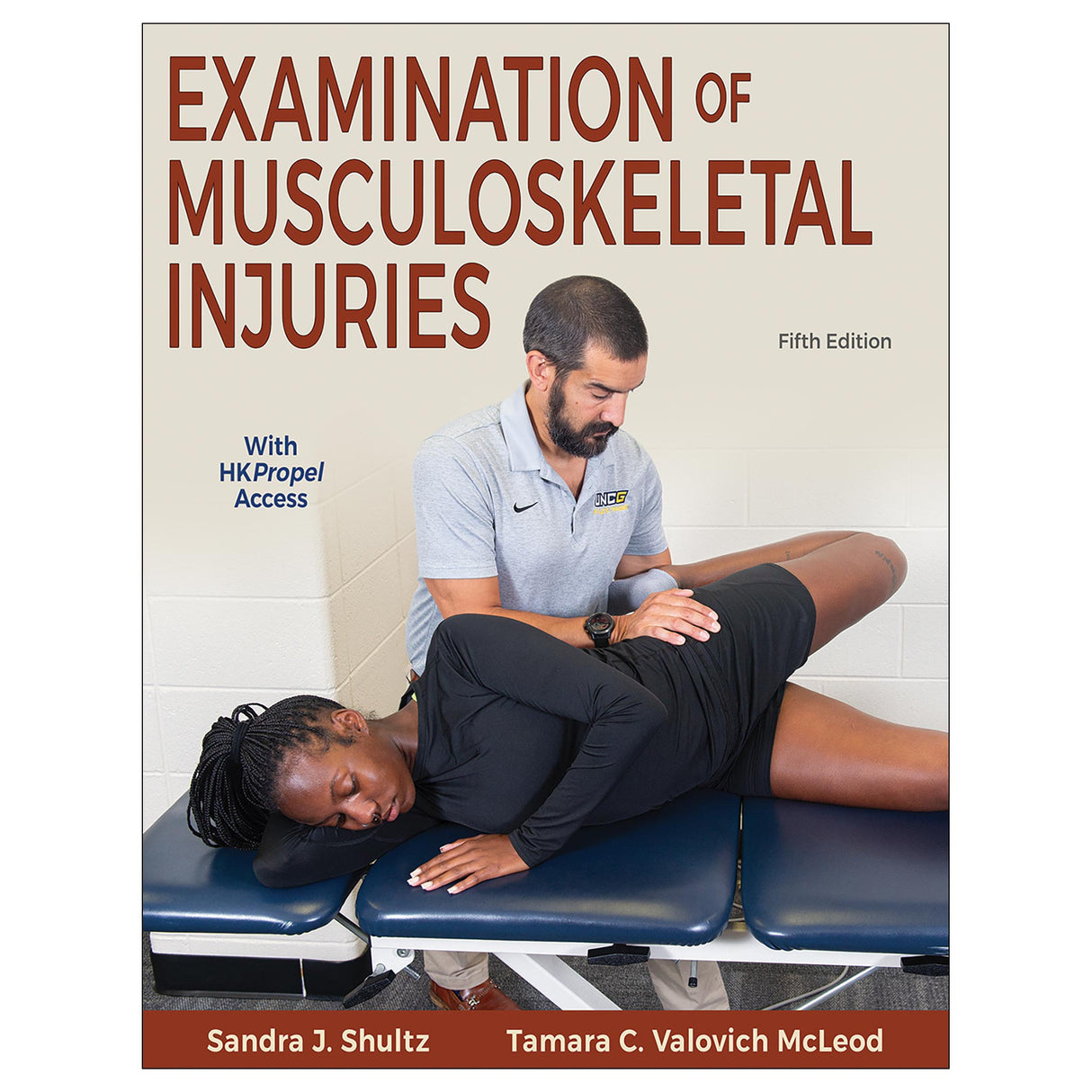Examination of Musculoskeletal Injuries 5th Edition Ebook With HKPropel Access
$145.95 CAD

From introductory skills for injury examination to specific techniques to be used for examining each region of the body, Examination of Musculoskeletal Injuries will teach students to obtain an accurate injury history from the patient, inspect the injury and related areas, palpate both bone and soft tissues, assess motion control and function, and examine neurological and cardiorespiratory status. The text includes special tests that are used to assess different structures and to rule out or diagnose injuries for that region. Strategies are offered for examinations that occur immediately after an injury as well as those that are seen later in a clinical setting. Full-color photos and medical artwork clarify testing techniques and enhance knowledge of body structures. Updates in this fifth edition include the following:
- An extensive video library with more than 190 new videos, for a total of 243 videos showcasing range of motion, muscle testing, and special test techniques
- The addition of 35 new special tests and injury-specific examinations: instructions; photos and videos demonstrating how to perform them; and sensitivity, specificity, and likelihood ratios to help drive a clinician’s choice in test and support the clinician’s diagnosis
- A new exploration of the latest concussion examination techniques, including the Sport Concussion Assessment Tool (SCAT), with a video that allows readers to observe and practice the SCAT
- A section on patient-reported outcome measures (PROMs) for each body region; a quick reference table features the most recommended PROMs and information on what they help assess
Examination of Musculoskeletal Injuries, Fifth Edition, is an essential resource for examining and differentiating the pathologies encountered in musculoskeletal systems. It will prepare athletic training students for certification and guide any clinician or therapist in diagnosing musculoskeletal injuries.
Note: A code for accessing HKPropel is included with this ebook.
Audience
Textbook for students studying athletic training, physical therapy, physiotherapy, and massage therapy. A reference for practicing athletic trainers, athletic therapists, physical therapists, physiotherapists, and other allied health professionals who perform musculoskeletal assessments.Chapter 1. Anatomical Nomenclature and Injury Classifications
Anatomical Reference Terminology
Physical Maturity Classifications
Injury Classifications
Closed (Unexposed) Wounds
Open (Exposed) Wounds
Summary
Chapter 2. Principles of Examination: An Overview
Proper Use of Terminology
Examination Components
Documenting the Examination
Summary
Chapter 3. Taking a History
General Principles
Situation-Specific History and Depth of Inquiry
Summary
Chapter 4. Observation
General Principles
Details of Specific Observation
Summary
Chapter 5. Palpation
General Principles
Structures to Palpate
Palpation Strategies
Summary
Chapter 6. Active and Passive Joint Range of Motion
General Principles
Prerequisites for Successful ROM Examination
Examination of Physiologic Range of Motion
Examination of Accessory Motion
Examination of Ligament and Capsule Integrity
Summary
Chapter 7. Muscle Testing
General Principles
Manual Muscle Testing
Instrumented Muscle Testing
Summary
Chapter 8. Neurological Status
General Principles
Region-Specific Neurological Examination
Summary
Chapter 9. Cardiorespiratory Status
General Principles
Examination of Cardiorespiratory Status
Shock (Cardiovascular Collapse)
Summary
Chapter 10. Putting It All Together: General Examination Strategies
On-Site Examination
Acute Examination
Clinical Examination
Summary
Part II. Region-Specific Examination Strategies
Chapter 11. Cervical and Upper Thoracic Spine
Functional Anatomy
Regional Examination
Injury Recognition and Special Tests
Injury Examination Strategies
Summary
Chapter 12. Shoulder and Arm
Functional Anatomy
Regional Examination
Injury Recognition and Special Tests
Injury Examination Strategies
Summary
Chapter 13. Elbow and Forearm
Functional Anatomy
Regional Examination
Injury Recognition and Special Tests
Injury Examination Strategies
Summary
Chapter 14. Wrist and Hand
Functional Anatomy
Regional Examination
Injury Recognition and Special Tests
Injury Examination Strategies
Summary
Chapter 15. Lower Thoracic and Lumbar Spine
Functional Anatomy
Regional Examination
Injury Recognition and Special Tests
Injury Examination Strategies
Summary
Chapter 16. Leg, Ankle, and Foot
Functional Anatomy
Regional Examination
Injury Recognition and Special Tests
Injury Examination Strategies
Summary
Chapter 17. Knee and Thigh
Functional Anatomy
Regional Examination
Injury Recognition and Special Tests
Injury Examination Strategies
Summary
Chapter 18. Hip, Pelvis, and Groin
Functional Anatomy
Regional Examination
Injury Recognition and Special Tests
Injury Examination Strategies
Summary
Chapter 19. Head and Face
Functional Anatomy
Regional Examination
Injury Recognition and Special Tests
Injury Examination Strategies
Summary
Chapter 20. Thorax and Abdomen
Functional Anatomy
Regional Examination
Injury Recognition and Special Tests
Injury Examination Strategies
Summary
What is the Sport Concussion Assessment Tool 6 (SCAT6)?
Why are Patient-Reported Outcome Measures (PROMs) important?




All ancillaries are free to adopting instructors through HKPropel.
Instructor guide. Includes learning objectives, chapter overviews, lecture outlines, and classroom activities and questions to aid with lecture preparation.
Test package. Contains 620 questions in true-false, fill-in-the-blank, essay, matching, and multiple-choice formats. The files may be downloaded for integration with a learning management system or printed for use as paper-based tests. Instructors may also create their own customized quizzes or tests from the test bank questions to assign to students directly through HKPropel. Multiple-choice and true-false questions are automatically graded, and instructors can review student scores in the platform.
Chapter quizzes. Contains ready-made quizzes (10 questions each) to assess student comprehension of the most important concepts in each chapter. Each quiz may be downloaded or assigned to students directly through HKPropel. The chapter assessments are automatically graded, and instructors can review student scores in the platform.
Presentation package. Features more than 1126 PowerPoint slides of text, artwork, and tables from the book that can be used for class discussion and presentation. The slides in the presentation package can be used directly within PowerPoint or printed to make handouts for students. Instructors can easily add, modify, and rearrange the order of the slides.
Image bank. Includes most of the figures, photos, and tables from the text, sorted by chapter. These can be used in developing a customized presentation based on specific course requirements.
Instructors also receive access to all student materials in HKPropel. For Examination of Musculoskeletal Injuries, this includes an expanded video package with over 240 videos of examination techniques, examination checklists and forms, flash cards, lab activities, case studies, and review questions.





